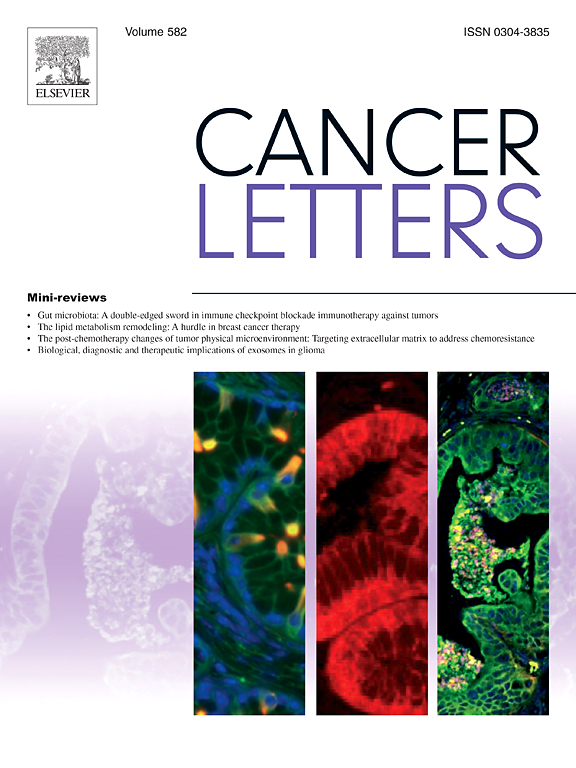Targeting MKK3/c-Myc interaction to overcome osimertinib acquired resistance in EGFR mutant lung cancer
IF 10.1
1区 医学
Q1 ONCOLOGY
引用次数: 0
Abstract
c-Myc inhibition is a critical mechanism in mediating the therapeutic efficacy of osimertinib against EGFR mutant (EGFRm) NSCLCs and accordingly targeting c-Myc is an effective strategy for overcoming osimertinib acquired resistance, a challenging issue in the clinic. However, lack of specific c-Myc inhibitors restricts the application of this strategy. The current study focused on determining the potential application of an alternative c-Myc inhibitory approach to overcome osimertinib acquired resistance via targeting the MKK3/c-Myc interaction that stabilizes c-Myc protein. SGI-1027, as the first disruptor of MKK3/c-Myc interaction, effectively decreased c-Myc levels via disrupting this interaction and promoting c-Myc degradation in different osimertinib-resistant EGFRm NSCLC cell lines that possessed elevated levels of both c-Myc and MKK3 and increased MKK3/c-Myc interaction. The combination of osimertinib with SGI-1027 synergistically decreased the survival of osimertinib-resistant cells and enhanced apoptosis. Consistently, MKK3 knockdown caused c-Myc reduction and sensitized osimertinib-resistant cells to undergo apoptosis upon osimertinib treatment. Moreover, the SGI-1027 and osimertinib combination was significantly more active than either single agent in suppressing the growth of osimertinib-resistant tumors in mice. In sensitive EGFRm NSCLC cell lines, osimertinib inhibited MKK3 and c-Myc interaction with reduction of c-Myc levels, suggesting a critical mechanism by which osimertinib induces c-Myc degradation. Hence, our findings reveal molecular mechanisms accounting for c-Myc reduction by osimertinib in sensitive EGFRm NSCLC cells and c-Myc elevation in EGFRm NSCLC with acquired osimertinib resistance. Our results also suggest a novel strategy to target c-Myc via disrupting the MKK3/c-Myc interaction to overcome osimertinib acquired resistance.
靶向MKK3/c-Myc相互作用克服EGFR突变肺癌中奥西替尼获得性耐药
c-Myc抑制是调节奥西替尼对EGFR突变体(EGFRm)非小细胞肺癌治疗效果的关键机制,因此靶向c-Myc是克服奥西替尼获得性耐药的有效策略,这是临床中一个具有挑战性的问题。然而,缺乏特异性的c-Myc抑制剂限制了这一策略的应用。目前的研究重点是确定一种替代c-Myc抑制方法的潜在应用,通过靶向稳定c-Myc蛋白的MKK3/c-Myc相互作用来克服奥西替尼获得性耐药。ssi -1027作为MKK3/c-Myc相互作用的第一干扰物,在c-Myc和MKK3水平升高、MKK3/c-Myc相互作用增加的不同奥西替尼耐药EGFRm NSCLC细胞系中,通过破坏这种相互作用并促进c-Myc降解,有效地降低了c-Myc水平。奥希替尼与SGI-1027联合使用可协同降低奥希替尼耐药细胞的存活率,增强细胞凋亡。同样,MKK3敲低导致c-Myc减少,并使奥希替尼耐药细胞在奥希替尼治疗后发生凋亡。此外,SGI-1027联合奥西替尼在抑制小鼠耐奥西替尼肿瘤生长方面的活性明显高于任何一种单一药物。在敏感的EGFRm NSCLC细胞系中,奥西替尼抑制MKK3和c-Myc相互作用,降低c-Myc水平,提示奥西替尼诱导c-Myc降解的关键机制。因此,我们的研究结果揭示了奥西替尼在敏感的EGFRm NSCLC细胞中降低c-Myc的分子机制,以及获得性奥西替尼耐药性的EGFRm NSCLC中c-Myc升高的分子机制。我们的研究结果还提出了一种新的策略,通过破坏MKK3/c-Myc相互作用来靶向c-Myc,以克服奥希替尼获得性耐药。
本文章由计算机程序翻译,如有差异,请以英文原文为准。
求助全文
约1分钟内获得全文
求助全文
来源期刊

Cancer letters
医学-肿瘤学
CiteScore
17.70
自引率
2.10%
发文量
427
审稿时长
15 days
期刊介绍:
Cancer Letters is a reputable international journal that serves as a platform for significant and original contributions in cancer research. The journal welcomes both full-length articles and Mini Reviews in the wide-ranging field of basic and translational oncology. Furthermore, it frequently presents Special Issues that shed light on current and topical areas in cancer research.
Cancer Letters is highly interested in various fundamental aspects that can cater to a diverse readership. These areas include the molecular genetics and cell biology of cancer, radiation biology, molecular pathology, hormones and cancer, viral oncology, metastasis, and chemoprevention. The journal actively focuses on experimental therapeutics, particularly the advancement of targeted therapies for personalized cancer medicine, such as metronomic chemotherapy.
By publishing groundbreaking research and promoting advancements in cancer treatments, Cancer Letters aims to actively contribute to the fight against cancer and the improvement of patient outcomes.
 求助内容:
求助内容: 应助结果提醒方式:
应助结果提醒方式:


